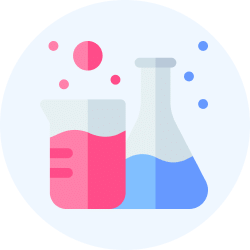Chemistry Exam > Chemistry Questions > Which part of the stearate ion is hydrophilic...
Start Learning for Free
Which part of the stearate ion is hydrophilic in nature?
- a)Tail
- b)Hydrocarbon chain
- c)Head
- d)None of the mentioned
Correct answer is option 'C'. Can you explain this answer?
Most Upvoted Answer
Which part of the stearate ion is hydrophilic in nature?a)Tailb)Hydroc...
Hydrophilic nature of Stearate ion:
Stearate ion is a negatively charged ion and is derived from stearic acid. It has a long hydrocarbon chain with a carboxylate group (-COO-) at the end. The hydrocarbon chain is nonpolar and hydrophobic in nature, whereas the carboxylate group is polar and hydrophilic in nature.
The hydrophilic nature of the stearate ion is due to the carboxylate group, which is made up of a carbonyl group (-C=O) and a hydroxyl group (-OH), both of which are polar in nature. The carbonyl group is electron-withdrawing, which causes the oxygen atom to become slightly negative, and the carbon atom to become slightly positive. Similarly, the hydroxyl group is electron-donating, which causes the oxygen atom to become slightly negative, and the hydrogen atom to become slightly positive.
The polar nature of the carboxylate group makes it attracted to water molecules, and thus, hydrophilic in nature. This allows the stearate ion to dissolve in water and form a stable solution.
Conclusion:
In conclusion, the head of the stearate ion, which is the carboxylate group, is hydrophilic in nature due to its polar nature.
Stearate ion is a negatively charged ion and is derived from stearic acid. It has a long hydrocarbon chain with a carboxylate group (-COO-) at the end. The hydrocarbon chain is nonpolar and hydrophobic in nature, whereas the carboxylate group is polar and hydrophilic in nature.
The hydrophilic nature of the stearate ion is due to the carboxylate group, which is made up of a carbonyl group (-C=O) and a hydroxyl group (-OH), both of which are polar in nature. The carbonyl group is electron-withdrawing, which causes the oxygen atom to become slightly negative, and the carbon atom to become slightly positive. Similarly, the hydroxyl group is electron-donating, which causes the oxygen atom to become slightly negative, and the hydrogen atom to become slightly positive.
The polar nature of the carboxylate group makes it attracted to water molecules, and thus, hydrophilic in nature. This allows the stearate ion to dissolve in water and form a stable solution.
Conclusion:
In conclusion, the head of the stearate ion, which is the carboxylate group, is hydrophilic in nature due to its polar nature.
Free Test
FREE
| Start Free Test |
Community Answer
Which part of the stearate ion is hydrophilic in nature?a)Tailb)Hydroc...
The end of the hydrocarbon chain is having a polar group (head) which is hydrophilic in nature and represented by a hollow circle.

|
Explore Courses for Chemistry exam
|

|
Similar Chemistry Doubts
Question Description
Which part of the stearate ion is hydrophilic in nature?a)Tailb)Hydrocarbon chainc)Headd)None of the mentionedCorrect answer is option 'C'. Can you explain this answer? for Chemistry 2025 is part of Chemistry preparation. The Question and answers have been prepared according to the Chemistry exam syllabus. Information about Which part of the stearate ion is hydrophilic in nature?a)Tailb)Hydrocarbon chainc)Headd)None of the mentionedCorrect answer is option 'C'. Can you explain this answer? covers all topics & solutions for Chemistry 2025 Exam. Find important definitions, questions, meanings, examples, exercises and tests below for Which part of the stearate ion is hydrophilic in nature?a)Tailb)Hydrocarbon chainc)Headd)None of the mentionedCorrect answer is option 'C'. Can you explain this answer?.
Which part of the stearate ion is hydrophilic in nature?a)Tailb)Hydrocarbon chainc)Headd)None of the mentionedCorrect answer is option 'C'. Can you explain this answer? for Chemistry 2025 is part of Chemistry preparation. The Question and answers have been prepared according to the Chemistry exam syllabus. Information about Which part of the stearate ion is hydrophilic in nature?a)Tailb)Hydrocarbon chainc)Headd)None of the mentionedCorrect answer is option 'C'. Can you explain this answer? covers all topics & solutions for Chemistry 2025 Exam. Find important definitions, questions, meanings, examples, exercises and tests below for Which part of the stearate ion is hydrophilic in nature?a)Tailb)Hydrocarbon chainc)Headd)None of the mentionedCorrect answer is option 'C'. Can you explain this answer?.
Solutions for Which part of the stearate ion is hydrophilic in nature?a)Tailb)Hydrocarbon chainc)Headd)None of the mentionedCorrect answer is option 'C'. Can you explain this answer? in English & in Hindi are available as part of our courses for Chemistry.
Download more important topics, notes, lectures and mock test series for Chemistry Exam by signing up for free.
Here you can find the meaning of Which part of the stearate ion is hydrophilic in nature?a)Tailb)Hydrocarbon chainc)Headd)None of the mentionedCorrect answer is option 'C'. Can you explain this answer? defined & explained in the simplest way possible. Besides giving the explanation of
Which part of the stearate ion is hydrophilic in nature?a)Tailb)Hydrocarbon chainc)Headd)None of the mentionedCorrect answer is option 'C'. Can you explain this answer?, a detailed solution for Which part of the stearate ion is hydrophilic in nature?a)Tailb)Hydrocarbon chainc)Headd)None of the mentionedCorrect answer is option 'C'. Can you explain this answer? has been provided alongside types of Which part of the stearate ion is hydrophilic in nature?a)Tailb)Hydrocarbon chainc)Headd)None of the mentionedCorrect answer is option 'C'. Can you explain this answer? theory, EduRev gives you an
ample number of questions to practice Which part of the stearate ion is hydrophilic in nature?a)Tailb)Hydrocarbon chainc)Headd)None of the mentionedCorrect answer is option 'C'. Can you explain this answer? tests, examples and also practice Chemistry tests.

|
Explore Courses for Chemistry exam
|

|
Signup to solve all Doubts
Signup to see your scores go up within 7 days! Learn & Practice with 1000+ FREE Notes, Videos & Tests.






















